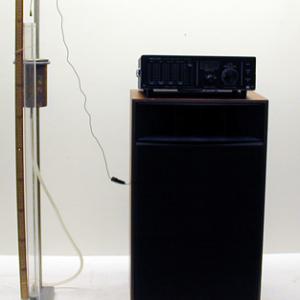College of Liberal Arts & Sciences
3D30.10 - Resonance Tubes - Water Column
Fill the movable cup with water. Place the tuning fork at the top end of the Plexiglas pipe. Strike the tuning fork and change the water level by moving the cup up or down. At some point you should find a position where the sound from the tuning fork becomes very loud. This should be 1/2 wave length and can be measured by the meter stick on the edge of the tube.
- Mamatha Ramanjineyulu Maddur, Arnab Bhattacharya, Praveen Pathak, "Studying Temperature-Dependent Sound Speed in a Constantly Filling Beaker Using a Smartphone", TPT, Vol. 62, #6, Sept. 2024, p. 487.
- Jim & Jane Nelson, "A New Look at an Old Activity: Resonance Tubes Used to Teach Resonance, TPT, Vol. 55, #9, Dec. 2017, p. 546.
- Alan Bates, "A New Resonance Tube", TPT, Vol. 55, #9, Dec. 2017, p. 544.
- Jeffrey D. Goldader, "Determining Absolute Zero Using a Tuning Fork", TPT, Vol. 46, # 4, April 2008, p. 206.
- Chuck Kappert, "Closed Tube With Varying Length", TPT, Vol. 44, # 9, Dec. 2006, p. 566.
- Peter Froehle, "Finding the Outdoor Temperature Using a Tuning Fork and Resonance", TPT, Vol. 44, # 6, p. 358, Sept. 2006.
- Don Easton "Speed of Sound in Air", TPT, Vol. 43, # 9, Dec. 2005, p. 567.
- Michael C. LoPresto, "Measuring End Correction for a Quarter-Wave Tube", TPT, Vol. 43, # 6, p. 380, Sept. 2005.
- James A. Warden, "Measuring the Speed of Sound Without Plumbing", TPT, Vol. 43, # 3, May 2005, p. 308.
- "Simple Sound Demonstrations", TPT, Vol. 36, # 1, p. 16, Jan. 1998.
- George F. Schuttinger, "A Very Quick and Very Cheap Velocity-of-Sound Lab", TPT, Vol. 34, # 6, Sept. 1996, p. 348.
- Jeffrey May, "A Standing Sound Wave Demonstration", TPT, Vol. 18, # 2, Feb. 1980, p. 145.
- Buford Guy, Jim Allen, "Velocity of Sound by Resonances", TPT, Vol. 12, # 3, Feb. 1974, p. 117.
- Bruce E. Lee, "A Modified Resonance in Air Experiment", TPT, Vol. 8, # 6, Sept. 1970, p. 336.
- William A. Bell, William M. Keller, "Constant - Volume Sound Source", TPT, Vol. 7, # 7, Oct. 1969, p. 406.
- Se-1: Freier and Anderson, A Demonstration Handbook for Physics.
- W- 255: "Resonance Tube", DICK and RAE Physics Demo Notebook.
- George M. Hopkins, "Sound", Experimental Science, p. 143.
- George M. Hopkins', "An Experiment in Resonance", Experimental Science, Volume Two, p. 206.
- Robert L. Dough, "Resonance Tube Modifications", Apparatus Notes, July 1965-December 1972, p. 55.
- Jearl Walker, "3.46, Jar and Beaker Resonance", The Flying Circus of Physics Ed. 2, p. 165.
- "Another Resonance Tube Demonstration", PIRA News, Vol. 8, No. 2, p. 32.
- "Organ Pipe", Science Snackbook, p. 72.1 - 72.2,
- Ron Hipschman, "Organ Pipe", Exploratorium Cookbook III, p. 187.1 - 187.3.
- D. Colson, C. J. Lapp, J. A. Eldridge, "Experiment XXXII", 1936 Univ. of Iowa Physics Laboratory Manual, p. 39.
- "Open and Closed Standing Wave Resonance Chambers", Worksheet and Instructions, Author unknown.
Disclaimer: These demonstrations are provided only for illustrative use by persons affiliated with The University of Iowa and only under the direction of a trained instructor or physicist. The University of Iowa is not responsible for demonstrations performed by those using their own equipment or who choose to use this reference material for their own purpose. The demonstrations included here are within the public domain and can be found in materials contained in libraries, bookstores, and through electronic sources. Performing all or any portion of any of these demonstrations, with or without revisions not depicted here entails inherent risks. These risks include, without limitation, bodily injury (and possibly death), including risks to health that may be temporary or permanent and that may exacerbate a pre-existing medical condition; and property loss or damage. Anyone performing any part of these demonstrations, even with revisions, knowingly and voluntarily assumes all risks associated with them.
